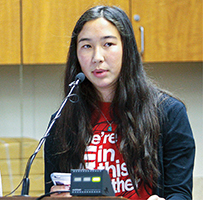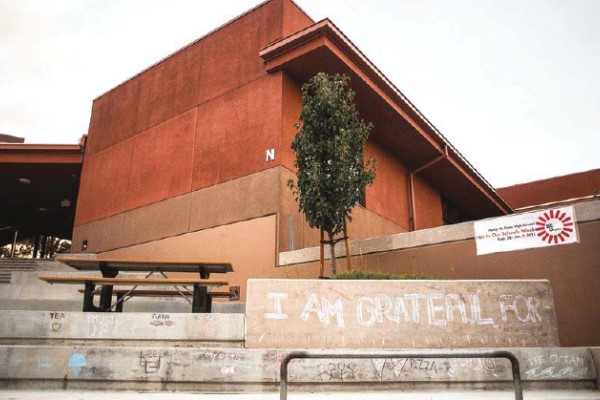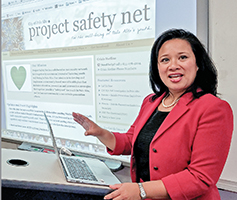Confronting Student Suicide
September 01, 2016
A superintendent’s inside story of how a high-achieving school district, in the aftermath of a cluster of deaths, consciously deals with prevention, intervention and postvention

My cell phone startled me awake around 2:15 a.m. “This cannot be good,” I thought as I fumbled for it bedside. It was not. But I never fathomed how bad it could be.
The police chief related that a 16-year-old high school student had died by suicide within the hour. This death followed the suicide of a 19-year-old recent graduate just two weeks earlier. Being new to the Palo Alto, Calif., Unified School District, I had not met either student, yet I was devastated.
In schools I’d previously led, we had lost children to cancer and fatal accidents, but somehow this felt worse. The specter of death by suicide was beyond comprehension. But there it was, in our own school community.
Research indicates that one suicide often triggers another. Our deepest fears and worst nightmares came true over the next few months as this death was followed by another. And another. The suicides of four teenagers in this high-achieving community shook us all to the core.
I had been a superintendent since 1988, serving in three local school districts and as state superintendent in Illinois, president of the Illinois Mathematics and Science Academy and founding head of the Princeton International School of Mathematics and Science, and I had seen my share of crises. But nothing was as tragic or intense as the suicide cluster I experienced during my first months as Palo Alto’s superintendent in fall 2014.
In the Aftermath
Applying lessons learned from an earlier suicide cluster in the district in 2009, we immediately applied our prevention and intervention protocols, including comprehensive anti-bullying, sexual harassment and homework policies. Our counselors developed detailed logic models with clear accountabilities. We wrote a strategic plan with a key goal of “support[ing] the social-emotional needs of students and celebrat[ing] personal growth across multiple dimensions, while ensuring a positive, safe and healthy environment.”

Attending to mental health and wellness had always been a priority of the district. Following the suicides, it was the priority.
After each death, we implemented a postvention protocol. My first calls were to the school’s principal, the district’s communications coordinator and each school board member. The communications coordinator and principal prepared a written message for staff, students and parents. We also informed our PTA Council president and the district’s director of student services, who in turn worked with the principal to deploy the crisis team. I approved the messages that were sent simultaneously to staff and families. Each message included resources for mental health supports.
The crisis team met at the school to plan for the coming days. Additional counseling services were obtained from other schools and the community. Experts in grief counseling gave the faculty insights into what to expect from students and how to respond. We scripted a common message for all faculty members to read during first period and encouraged them to provide space for discussion, grief and coping. We asked them to hold off on homework and tests for a day or two and then ease back into the routine.
The biggest challenge of postvention was the depth and breadth of emotions and subsequent time needed to transition from shock to a normal routine. Although most students and staff needed just a day or two of grieving, some teachers and counselors were affected to the extent that they needed personal leaves or left the district entirely.
Unexpected Targeting
We had learned a lot from the earlier cluster, but it was not enough. We had not anticipated how intense the finger-pointing would be. The immediate reaction of many terrified parents was to blame the schools: too much homework, too much competition, uncaring teachers, lack of leadership, depressing books in literature classes, dreary wall colors. The list went on and on.
Some educators and parents pointed fingers at other parents: too many “tiger parents,” too much emphasis on GPAs and APs, too much competitive intensity about getting into top universities, too much overprotectiveness.
We were all quick to point fingers at the community as well: too much affluence, too much competition, too much financial stress, too few hospital beds, too many fast trains, too much media attention.
And then there was the cyberbullying of teachers, parents, education leaders and even students in the anonymous blogs and comments on published articles. While finger-pointing was to be expected, the vitriol was not. Any school that experiences a student
suicide should brace for a tsunami of blame that can feel like a wave of destruction. However, advanced preparation can mitigate the deleterious impact.

Lessons Learned
Eventually, cooler heads prevailed. We knew much about suicide prevention, but we learned much more over the course of the cluster and in its immediate aftermath.
We learned first-hand from national experts on adolescent suicide, such as Columbia University’s Madelyn Gould and Morton Silverman of the JED Foundation, Stanford professors Shashank Joshi and Rebecca Bernert, and community partners, including pediatricians and psychiatrists at the Palo Alto Medical Foundation, Lucille Packard Children’s Hospital and the Health Care Alliance for Response to Adolescent Depression. We learned from sleep research compiled by the American Academy of Pediatrics and from popular literature, including Francis E. Jensen’s The Teenage Brain: A Neuroscientist’s Survival Guide to Raising Adolescents and Young Adults. Thanks to our county health director, we obtained the services of the Centers for Disease Control and Prevention in conducting an Epi-Aid investigation of risk factors within the community and across the county.
We also learned from our students and their parents. We conducted numerous student focus groups and parent forums and surveyed both groups extensively. From all of these sources our key learnings about suicide prevention were:
The crucial role of partnerships. One should never go it alone. Engage the help of experts in the field of mental health broadly and suicide prevention specifically.
The importance of sleep. Sleep deprivation had been a common element in some of the deaths.
The prevalence of depression. Our community pediatricians provided evidence that approximately 25 percent of students had significant mental health concerns.
The importance of vigilant students. The students are essential experts in identifying behavior changes or worrisome social media posts among their peers and letting adults know of potential devastating problems. Provide them with evidence-based depression education.
The role of the “suicide hotspot.” Palo Alto has what the experts call a hotspot — in our case, a speeding train that runs right through town 90 times per day. The train track is our hotspot equivalent of the Golden Gate Bridge. Eliminating, or at least restricting, the hotspot as a means of suicide is an effective prevention measure. Three of the four students in the recent cluster — and all of those in an earlier cluster — died at or near main train crossings in town
We learned this about intervention:

The need to destigmatize counseling. This stigma needs to be addressed, especially among those parents who became successful on their own and who believe it is weak or shameful for a young person to seek help for a mental health concern.
The need for community mental health services. Students must have access to hospital beds when the critical need arises and to proper outpatient services for ongoing care.
The need to break down health insurance obstacles. These barriers keep students from much-needed medication, counseling and services by medical professionals.
As for postvention, we learned:
The news media is ubiquitous and relentlessness. The competition to break the latest story can be fierce. We insist the media outlets follow our guidelines about reporting responsibly.
The need for broad and deep supports. These are not just for students and parents, but also for teachers, counselors and principals.
The need for parent education.
Education to promote understanding of mental health issues must be available to all parents in their language.

Knowledge into Action
These are some of the actions the school district took based on our experiences.
Immediate intervention. The district took decisive action to hire a mental health specialist for each high school and to increase funding for the culturally focused and community-based organizations, such as Asian Americans for Community Involvement and Adolescent Counseling Services. We also worked with the city and county to ensure that students had access to emergency support and mental health beds.
Postvention. The school and community responded with numerous parent and community forums, facilitated by mental health experts for listening and sharing resources for community health support. We also conducted several student focus groups and extensively surveyed parents and students.
We immediately increased counseling supports for mental health and wellness promotion and began messaging to remind parents and students of the importance of sleep and the dangers of the performance arms race — the relentless drive for the highest GPA and most resume-building activities.
We provided release time for high school teachers to engage in professional learning about self-care and wellness promotion and to direct students in mindfulness activities. The high schools sponsored a series of awareness events and students themselves led themed activities known as “Changing the Narrative” and “Titan Strong” that gave students a forum in print and social media for sharing positive stories of hope and resilience. The students’ self-initiated actions, including chalk art and youth forums, made a tangible difference, as did their vigilance in looking out for one another.
Parent education workshops sponsored by our PTA Council and Asian Parent Association played a positive role in both understanding the issues and dialing back the academic pressure of the performance arms race.
Our community leaders, school
board members and city and school staff revitalized Project Safety Net (www.psnpaloalto.com), an organizational network of city, school and community leaders and doers
dedicated to fostering youth well-being and suicide prevention.
PSN engaged community leaders in conversations, using the Collective Impact Model that led to actionable outcomes around data collection and to discussions with Caltrain, the regional commuter rail, about ways to restrict access. If we could delay an impulsive action, we might save lives. Thanks to the city of Palo Alto, track guards now physically monitor the five track intersections 24/7. The city and Caltrain also provided significant funding for effective fencing and vegetation removal (where an individual could hide before stepping to his or her death) and electronic trip wires and an intruder detection system to alert train conductors.
Prevention. Because suicide is such a complex problem, we launched systemwide preventive actions.
Physicians at the Stanford Center for Sleep Sciences and Medicine were especially helpful, as were pediatricians from the Palo Alto Medical Foundation, and others from the Health Care Alliance for Response to Adolescent Depression, who made compelling public cases about the need for our high school kids to get more sleep.
Leaders of the school board and district followed through by tackling student sleep deprivation and stress. While Gunn High School officially started at 8:25 a.m., at the time of the cluster, more than 300 students were enrolled in “zero period” — an optional early-morning opportunity for students to take additional classes or ensure a break later in their seven-period day. Despite an outpouring of objections from students and some parents, we eliminated zero period beginning the following year.
We took decisive action to better communicate homework guidelines and passed policy language to cap it at 15 hours per week. The school developed a time management form that parents and students had to sign acknowledging that taking three or more AP classes could be a significant health hazard and committing to ensuring students got the necessary sleep or dropped an AP class.
Arguably, the boldest prevention initiative was the move from a traditional seven-period day to a block schedule. That February, we tasked school leadership to design and institute a block schedule within three months for implementation the following year. This arduous task was made possible by Denise Herrmann, Gunn’s courageous principal; Ken Yale, a skilled facilitator; and a thoughtful, dedicated committee of students, parents, faculty and staff who sacrificed countless hours of work, study and family time.
Now, one year later, it has proven an extraordinary success. Longer class periods give teachers more time for meaningful interaction with students and longer classes enable students to have extended breaks during the day to catch up with friends and get some work done. Having fewer classes means less homework each night; longer passing periods give students more time to engage with teachers and to transition between classes; and adding a tutorial period assures more help for students in need. Students report they have less stress and less homework, and get more sleep.
Our Successes
We were able to make a positive difference in our schools and beyond.
We took quick, decisive action. Convening the crisis team over the weekend with daily followups, arranging for additional counseling and coverage, and being up front with parents and students were essential actions. The school system’s leaders displayed remarkable fortitude despite their deep pain. The support of our partners, especially local pediatricians and mental health clinicians, mattered a great deal. Their professional expertise and physical presence at meetings and on campus conveyed the urgency for action.
We adjusted policies. The board’s quick move on the policy front, while controversial, demonstrated tangible commitment to the students. Clearly communicating the homework policy and recommending the homework cap, removing the zero period, mandating a new schedule and requiring time management forms from parents and students when scheduling classes were not always well-received, but they had a positive impact.
Students and staff followed suit with Changing the Narrative, mental health awareness and stigma-reduction clubs and extended vigilance. Parents convened PTA parent education sessions, connected with the city and Caltrain on monitoring and restricting access to the railroad tracks, and cultivated supports for parents.
We destigmatized counseling. Along with Project Safety Net, our students and parents took the lead in making it acceptable for students and families to seek personal counseling support.
We spotlighted the “hot spot.” Lauren Barley, parent of a Palo Alto High School student and an organizational researcher, conducted an extensive study on the effectiveness of restricting accessible means of suicide. She further developed a compelling presentation for Caltrain, which with our messaging and unwavering support of city leadership, made the case for reducing accessibility to the train tracks a priority prevention measure.
Remaining Improvements
We continue to learn from the tragedies as well as our own missteps, and openly identify those areas where we can and must do better.
Supporting faculty. What I most regret is not recognizing the immediate need to support faculty members, counselors and administrators who were grieving so deeply (see related story, “ Managing My Own Emotions”).
It had not occurred to me to acknowledge or address their pain and to be more attentive to their needs. The faculty carried on heroically, but many were reeling, and we should have given their mental wellness our fullest attention.
Supporting families. Our administrators and teachers were not prepared or trained to handle the raw emotions. When a hysterical parent breaks into a meeting screaming that school should be cancelled, when a child breaks down in our office, when a parent blames herself or a teacher feels intense guilt, we do not have the capacity as school leaders to provide immediate support.
Understanding the turmoil that churned within some individuals was so far beyond my experience that I could only listen and offer a few comforting words. In the future, we must incorporate professional training to build our skills to support others.
Managing the national media. While we expected and received an onslaught of coverage, we underestimated the global focus on Palo Alto. In retrospect, we should have been more vocal and direct in not affording them unfettered access to our plight. While we worked hard to communicate the positive steps we had taken for both prevention and intervention, the national media largely focused on the tragedy, which in turn depressed morale for both school-based and broader communities.
Hope for the Future
Our district’s goals around differentiated instruction, consistency in grading and homework, and innovative academic program development were relegated to the back burner as mental health and wellness and social-emotional learning assumed paramount importance. Today, our district goals reflect a more intentional balance: high-quality teaching and learning, equity and access, and student wellness.
The problem of suicide thus far has proven too complex to be solved. The many changes we’ve implemented have made a positive difference, but no way exists to measure the return on the substantial investment by the district, city and community.
Is it a good sign that more families are seeking counseling? Do more students seeking counseling signal even more stress on their lives or is it a positive outcome of destigmatizing counseling and funding more mental health clinicians?
Which is the more positive metric: increased or decreased numbers of hospitalized students? Are fewer kids hospitalized because they are seeking and finding effective supports sooner or have they found better ways to mask their symptoms?
Does preventing students from taking too many AP courses reduce academic pressure or deprive them of classes they want to take because they like the academic challenge?
The metric that matters most is that we don’t lose another young person to suicide. It is public enemy No. 1 in Palo Alto, and it eludes capture. However, we hope by continuing to work together, truly together, to recognize and combat mental illness,
to curb impulsive responses to suicidal ideation, to restrict the access to means and to instill hope, belonging, purpose, joy and meaningful connections with a caring adult in every school, we can keep this menace at bay.
About the Author
Max McGee is superintendent of Palo Alto Unified School District in Palo Alto, Calif.
The District’s Toolkit for Others
The staff in the Palo Alto, Calif., district developed the Palo Alto Comprehensive Suicide Prevention Toolkit for Schools, a free resource available to other school systems.
The toolkit, produced in conjunction with local and national experts, describes in step-by-step detail what needs to be done in both the immediate and long-term aftermath of a suicide. It contains sample forms, communication templates and sequential timelines
detailing who should do what and when. The toolkit also has numerous suicide prevention resources.
Other resources include:
- American Foundation for Suicide Prevention, www.afsp.org
- National Suicide Prevention Lifeline, 800-273-TALK
- Reachout.com, online services for youth who need support
- Suicide Prevention Resource Center, www.sprc.org
- Trevor Project Lifeline, specializing in crisis help for GLBTQ youth, 866-488-7386
-- MAX MCGEE
Advertisement
Advertisement
Advertisement
Advertisement



